
Posted on 07/29/2014 4:32:16 AM PDT by Homer_J_Simpson

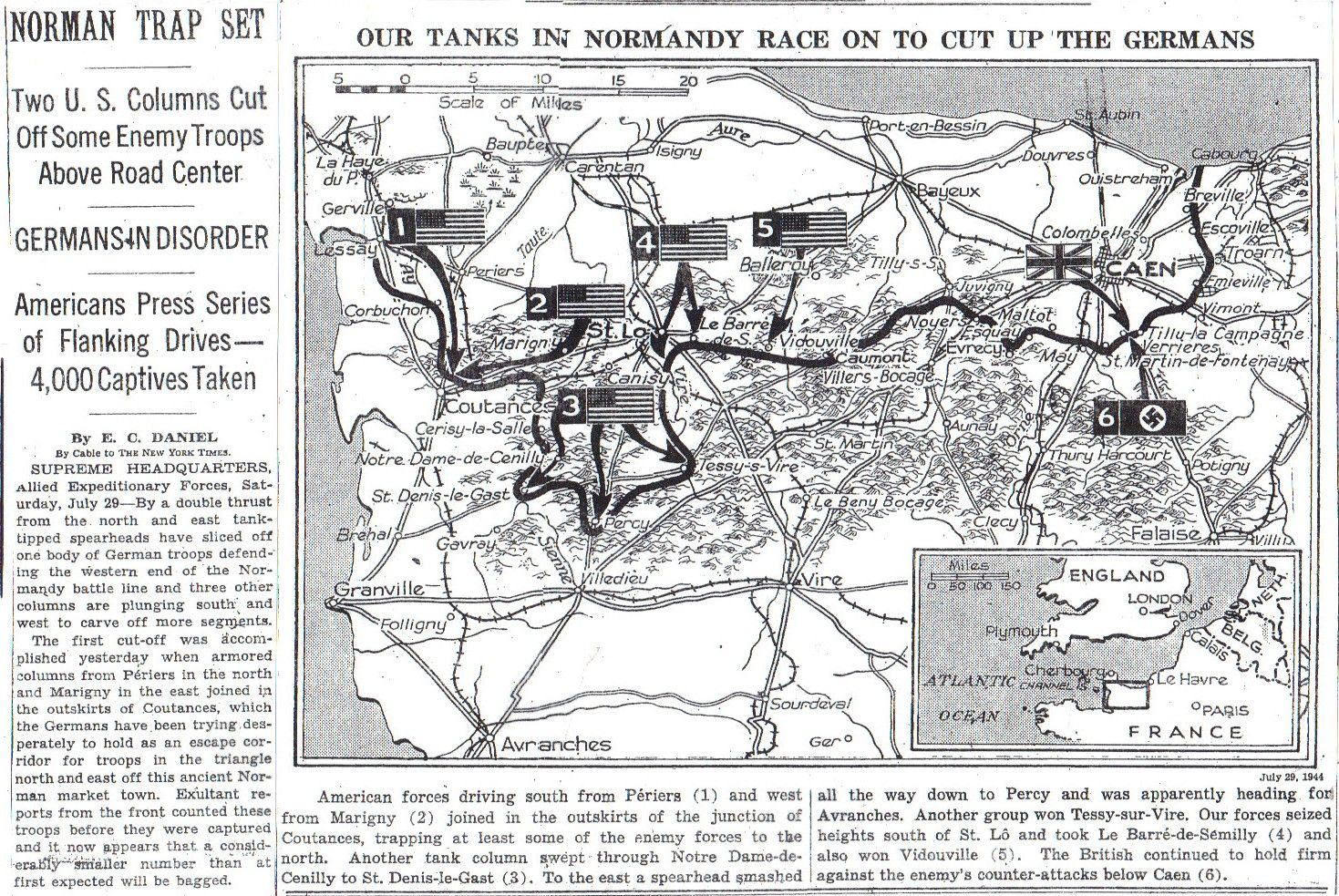
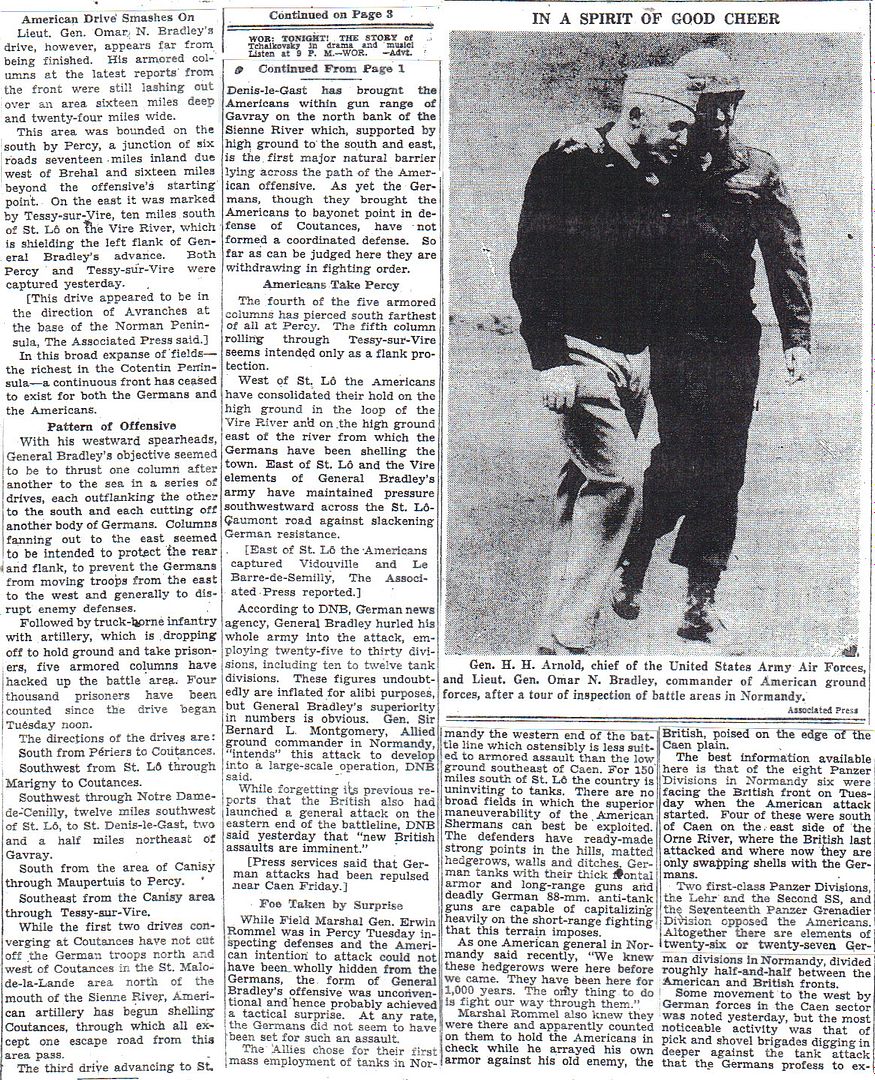
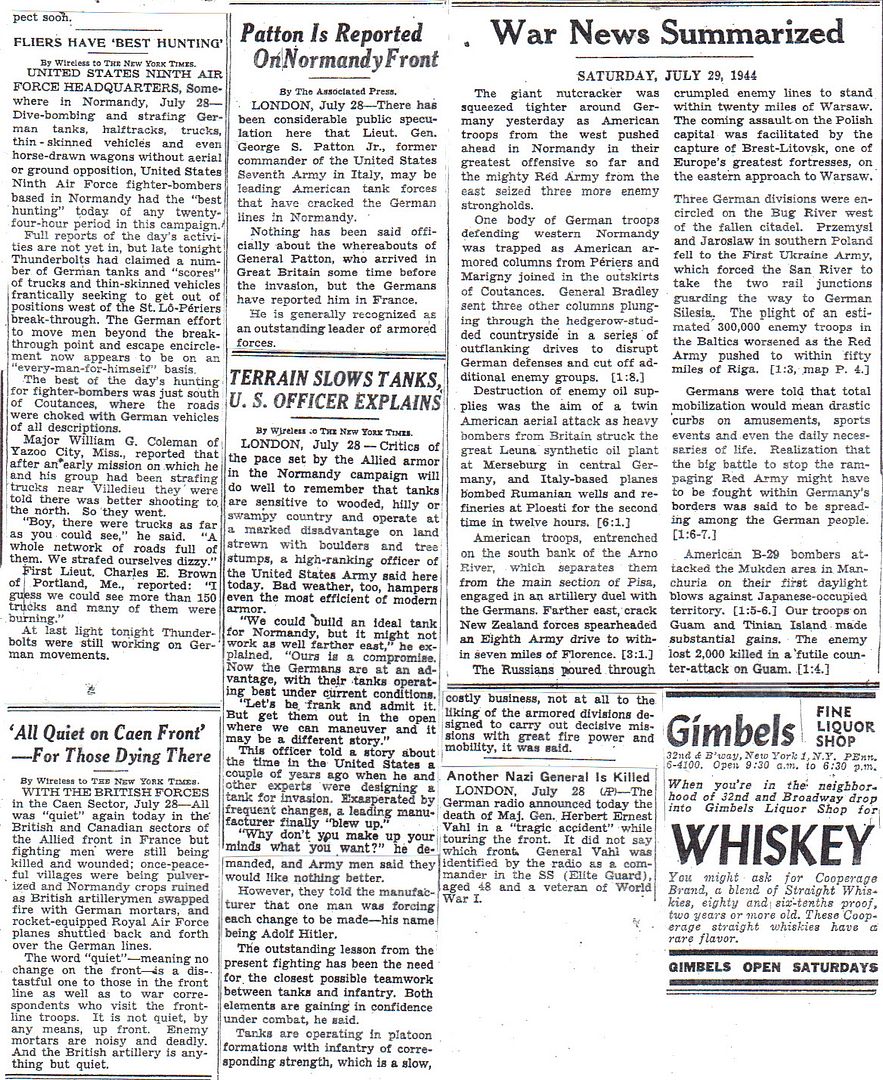

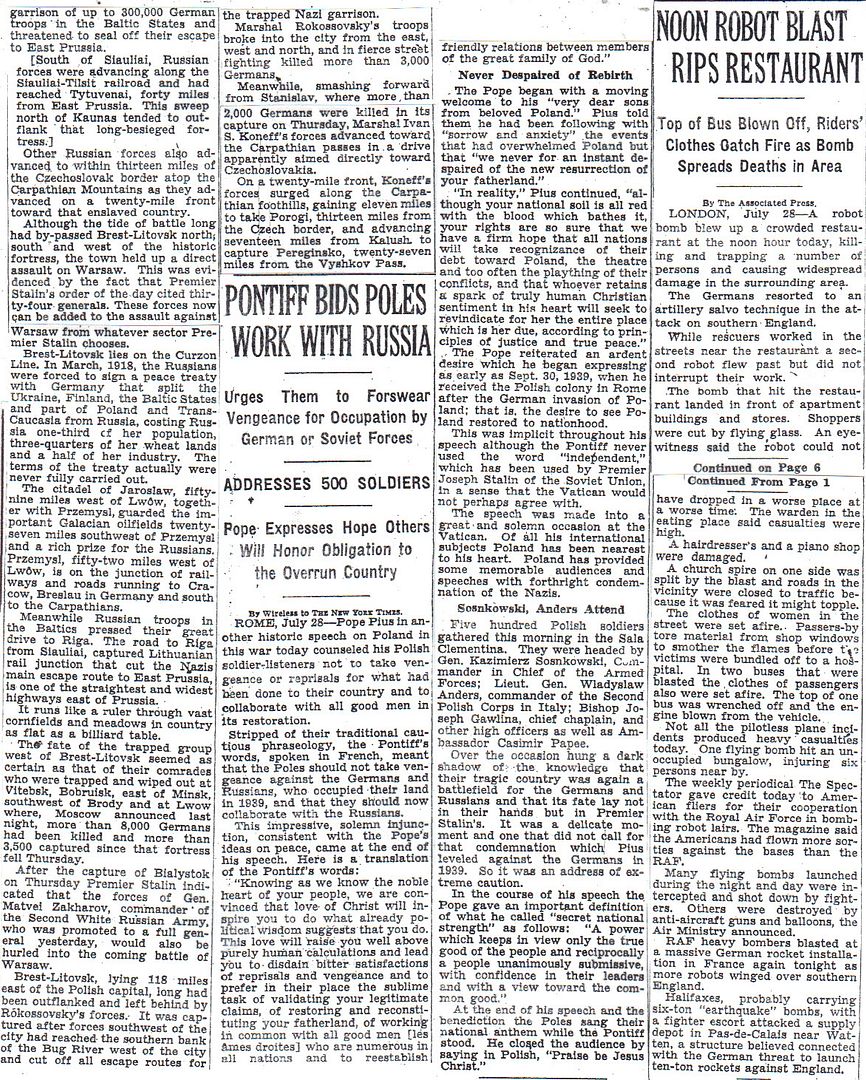
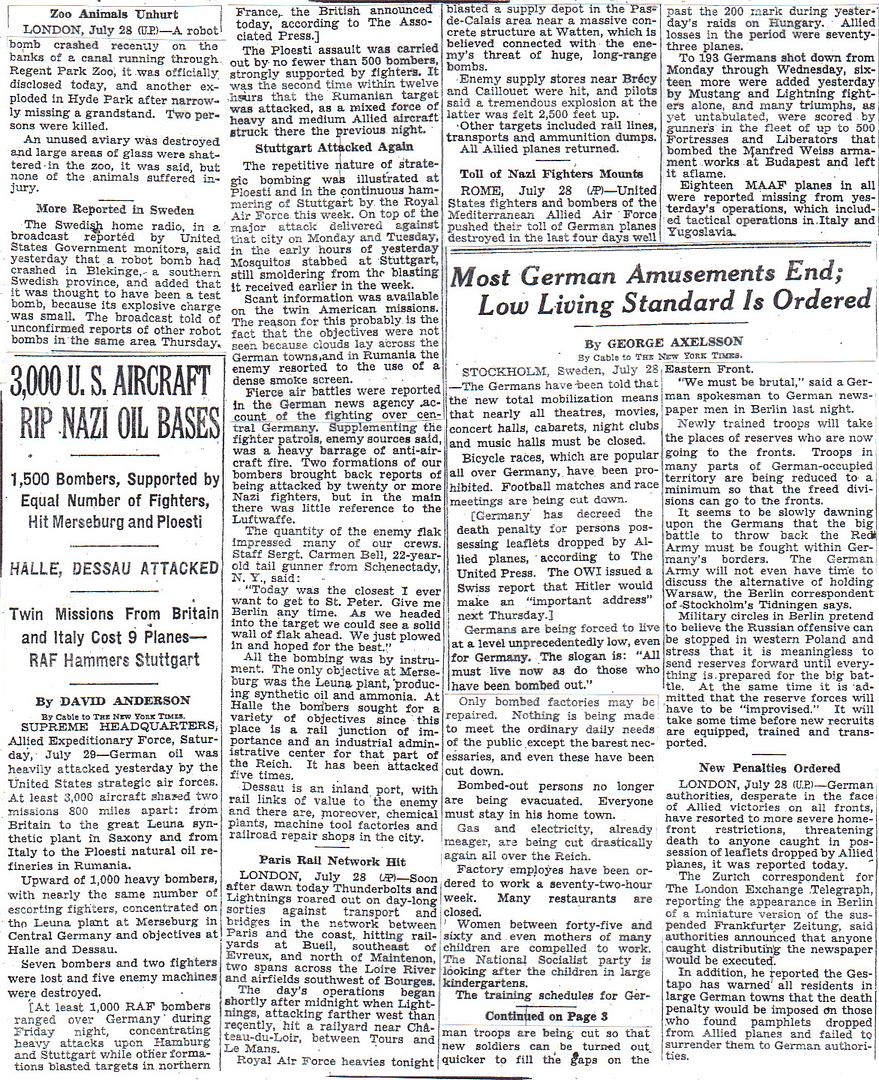
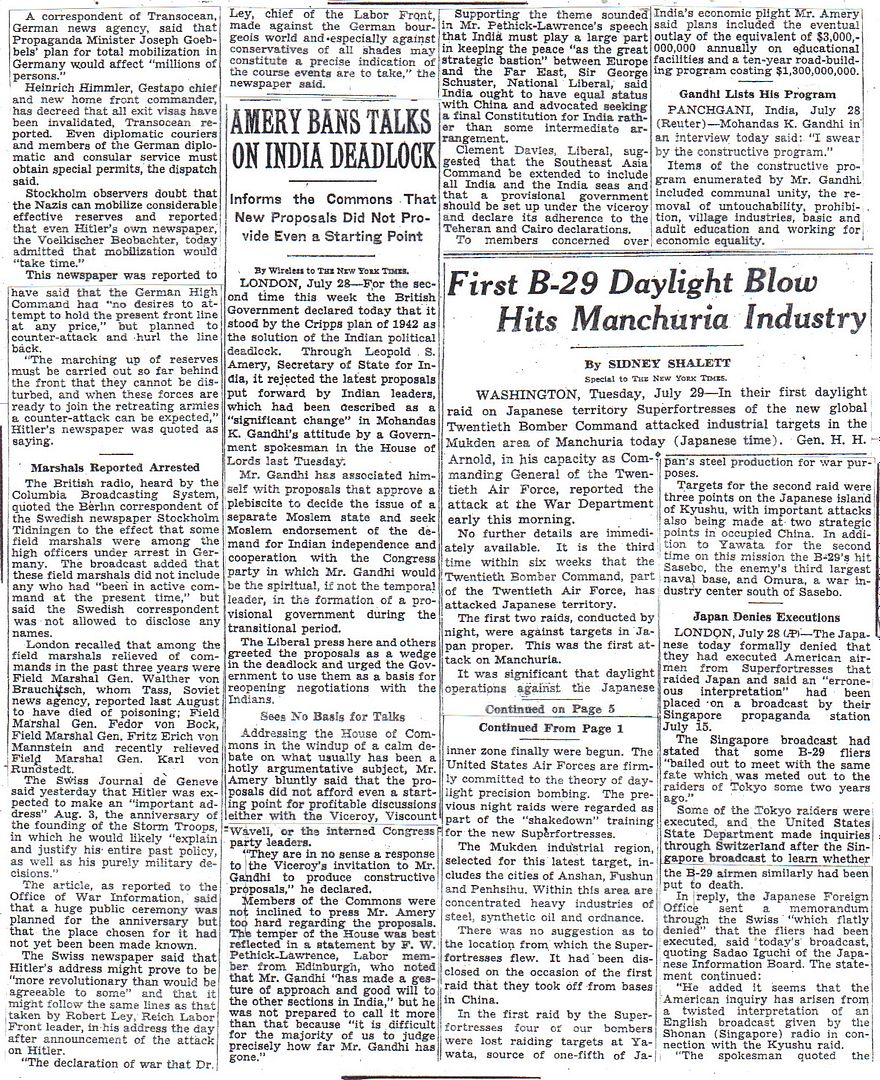
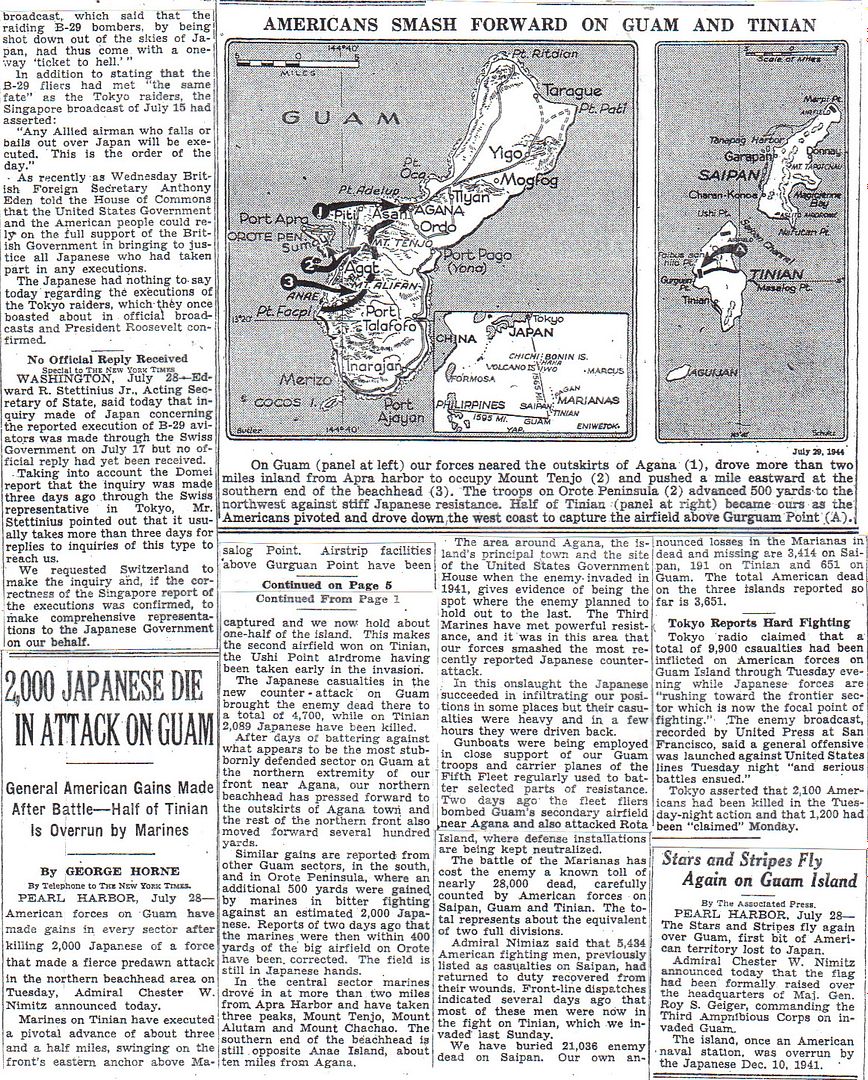
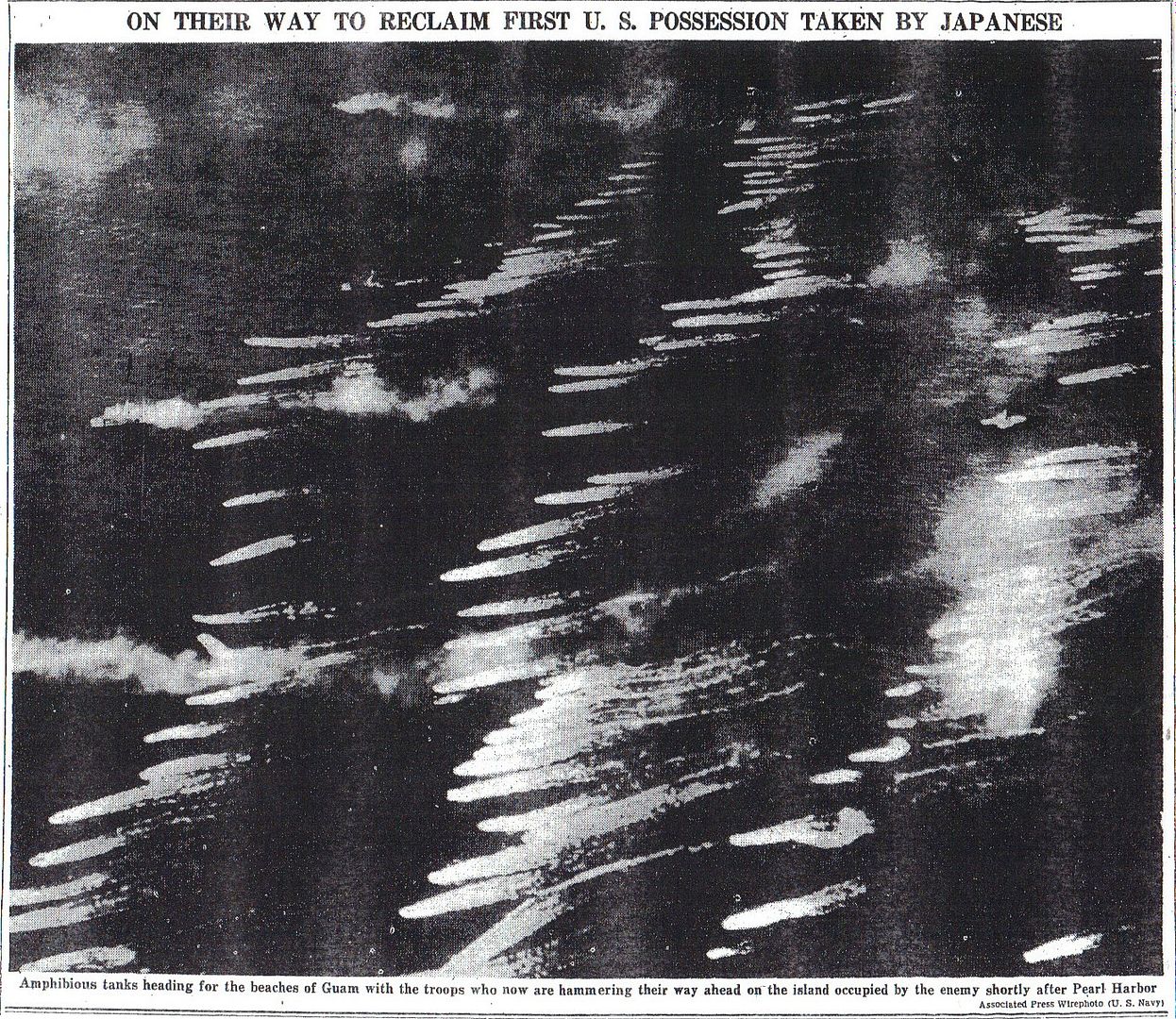
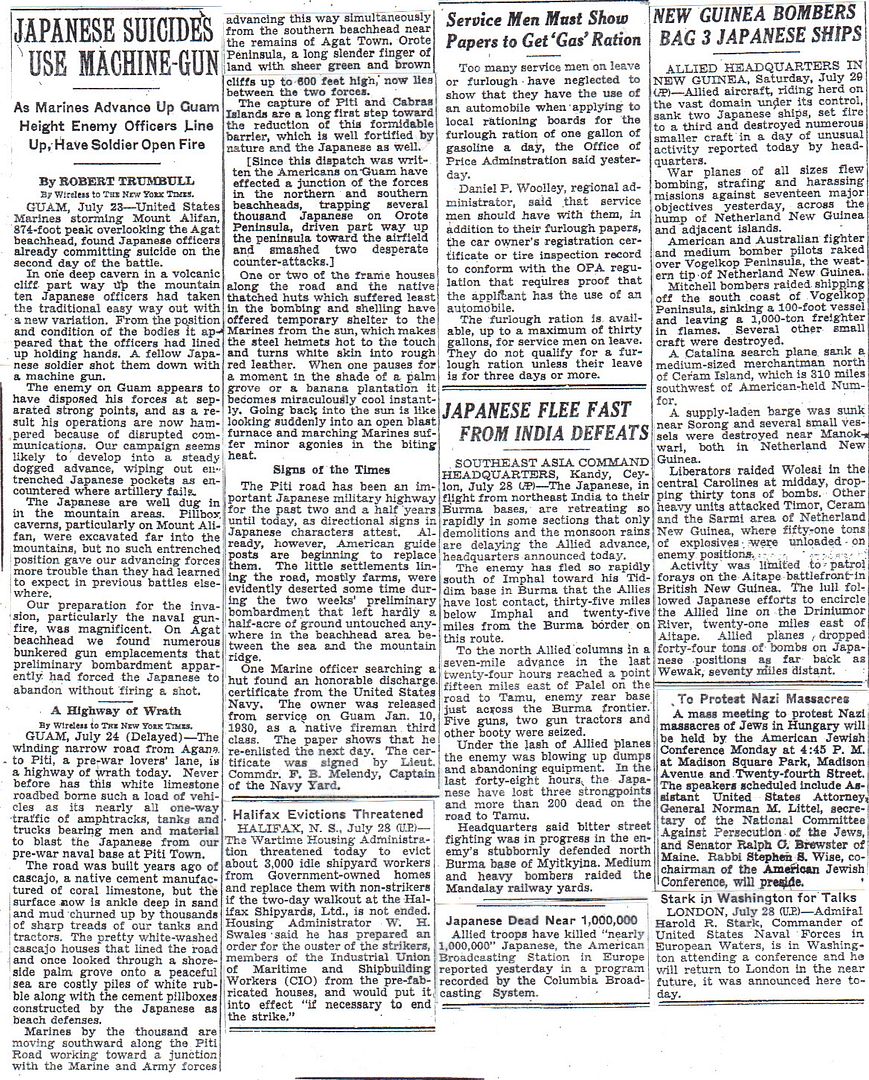
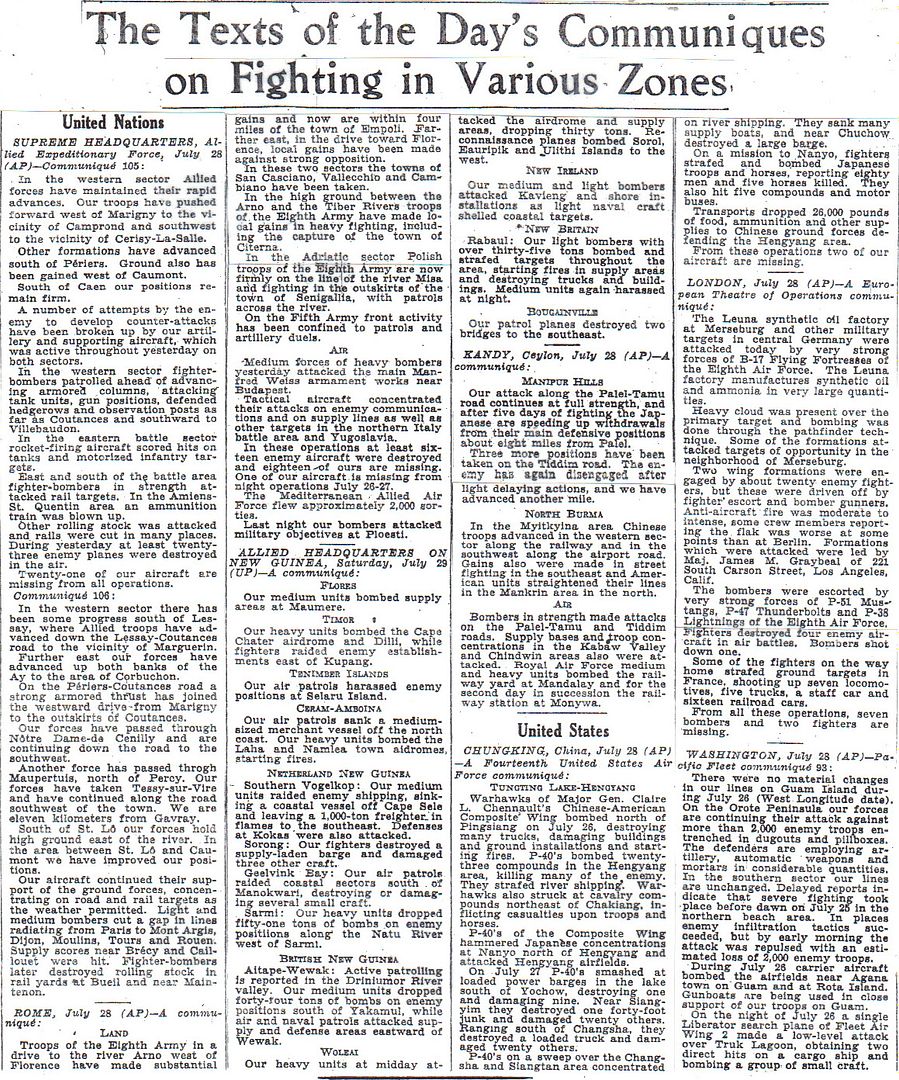
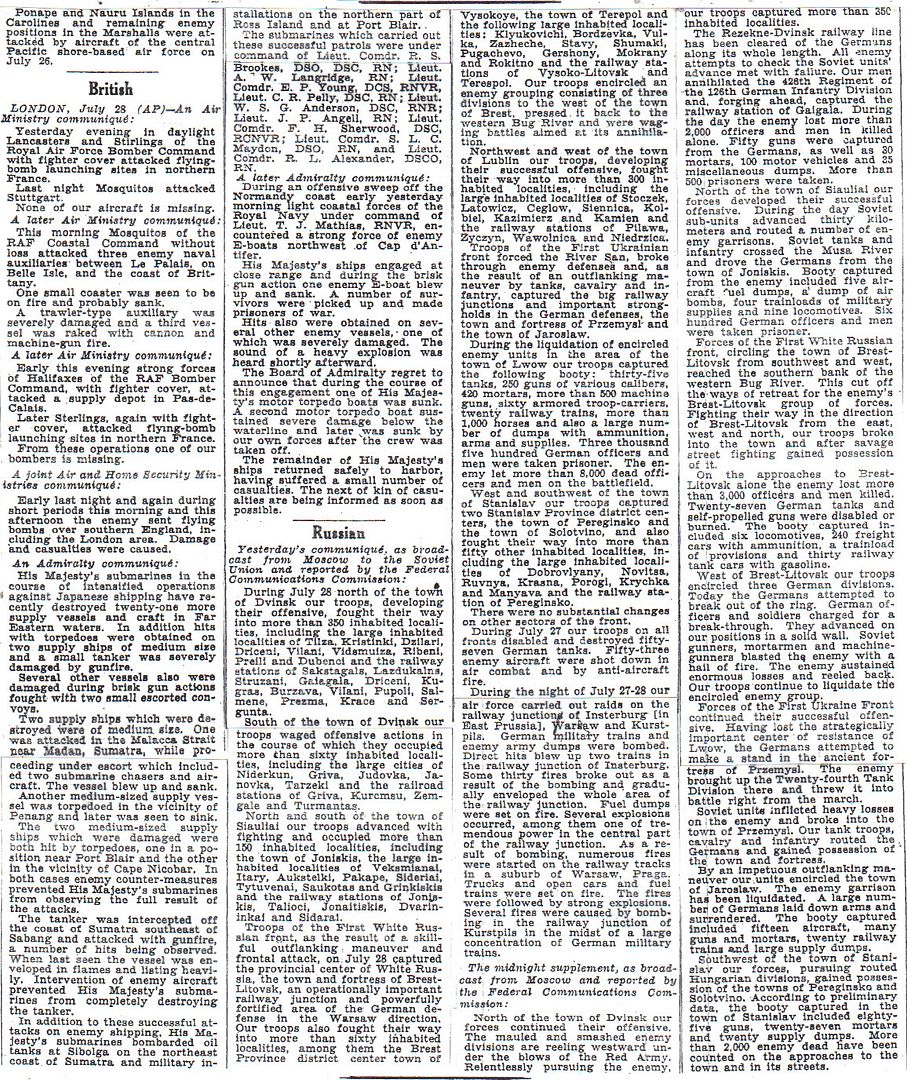
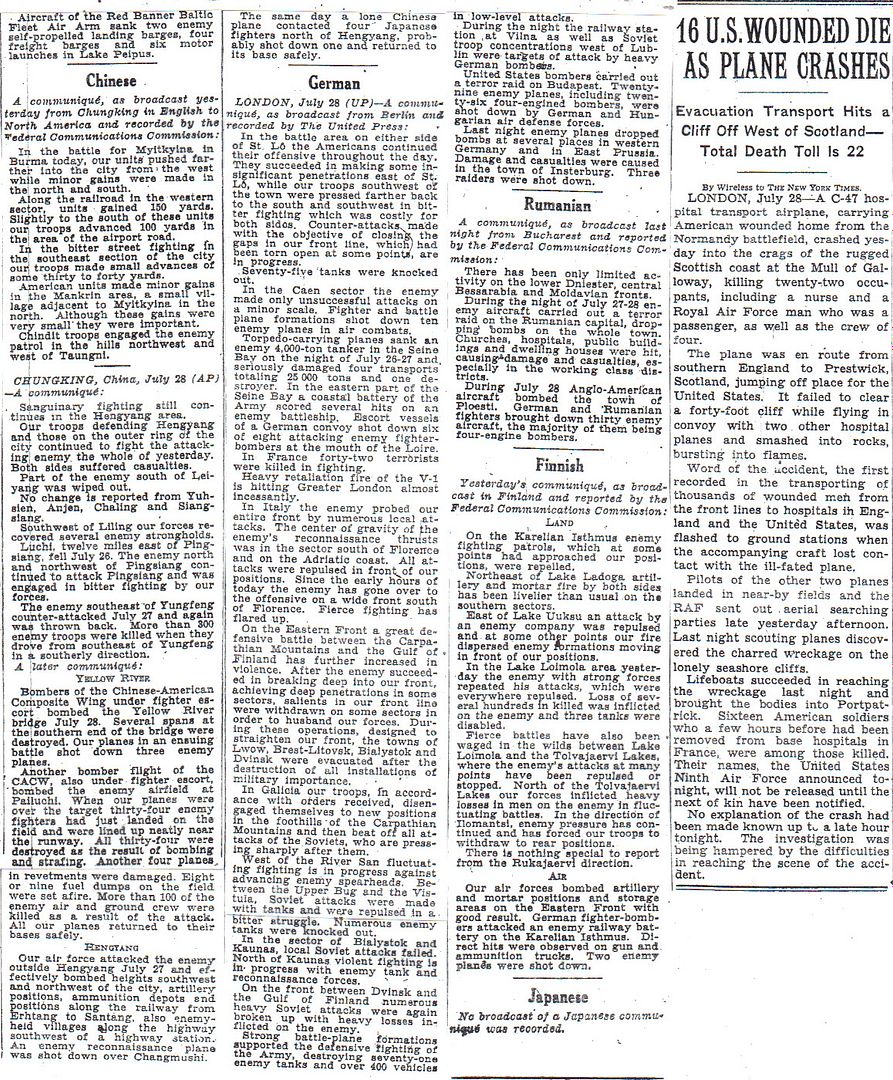
#1 - “I’ll Be Seeing You” – Bing Crosby
#2 - “Swinging on a Star” – Bing Crosby
#3 – “I’ll Get By” - Harry James, with Dick Haymes (reissue of 1941 recording)
#4 – “I’ll Be Seeing You” – Tommy Dorsey, with Frank Sinatra
#5 - “G.I. Jive” – Louis Jordan
#6 – “Amor” - Bing Crosby
#7 - “His Rocking Horse Ran Away” – Betty Hutton
#8– “Good Night, Wherever You Are” – Russ Morgan
#9 - “Long Ago (and Far Away)” – Jo Stafford
#10 - “Amor” – Andy Russell
http://www.onwar.com/chrono/1944/jul44/29jul44.htm#
Soviets cross the Niemen
Saturday, July 29, 1944 www.onwar.com
On the Eastern Front... The Soviet 3rd Belorussian Front crosses the Niemen River.
On the Western Front... The advance of US 1st Army continues. On the left flank, the US 19th Corps approaches Torigny and Tessy. The 7th Corps reaches Percy. On the right flank, the 8th Corps crosses the Sienne River and moves toward Granville.
In the Mariana Islands... On Tinian, the American forces now occupy more than half the island. Japanese resistance is increasing.
On New Guinea... On Biak the last pocket of organized Japanese resistance, around Ibdi, is eliminated. On the mainland, near Aitape, American forces fall back at Afua under pressure from Japanese forces.
http://www.etherit.co.uk/month/thismonth/29.htm
July 29th, 1944 (SATURDAY)
UNITED KINGDOM: The US Eighth Air Force flies 2 missions:
- Mission 503: 1,228 bombers and 755 fighters are dispatched to hit oil targets in Germany and airfields in France in 3 groups; 17 bombers and 7 fighters are lost.
(1) 569 B-17s hit the Leuna synthetic oil plant at Merseburg, 13 hit Gottingen, 11 hit Hildesheim marshalling yard, and 10 hit targets of opportunity; 15 B-17s are lost. Escort is provided by 429 P-38 Lightnings, P-47 Thunderbolts and P-51 Mustangs; 7 P-51s are lost.
(2) 442 B-24s hit the Oslebshausen oil refinery at Bremen, 2 hit targets of opportunity and 1 hit Cuxhaven; 2 B-24s are lost. Escort is provided by 106 P-51s.
(3) 38 B-24s hit Juvincourt Airfield and 26 hit Couvron Airfield at Laon, France. Escort is provided by 142 P-51s.
- Mission 504: 6 B-17s drop leaflets in France during the night.
Cap. Arthur Jeffrey (479th FG) claimed a Me 163 destroyed, but probably the enemy plane managed to escape in a vertical dive, as no losses were reported in German records for that day. (77)
- 44 B-24s are dispatched on CARPETBAGGER missions; 12 abort.
Personal Memory: My diary reads: “Mersberg, Germany, (near Leipzig.) Same target as yesterday. (Leuna Oil Works.) Saw terrific dog fights over target between our P-51s and enemy fighters. Target CAVU and FLAK was terrific. Got several holes this time. Had third new crew. Carried 20 X 250-pound general purpose bombs. Flight time, 8 hours and thirty five minutes. Over enemy territory 4 hours and twenty minutes.” I was flying the “Betty Jane” again today for an assault on Germany’s most heavily defended city. My new crew for today was that of Lt. P. F. Cureton, Jr. Ironically and tragically he was to be killed in action on November 21st at this very same target. The only survivor of his nine man crew would be Radio Operator, Tech Sgt. J. A. Ellis German farmers would murder most of the others. The navigator was hanged on the spot and Cureton and his copilot were stabbed to death with pitch forks. This kind of treatment was not unusual when one bailed out over Germany itse lf, but was rare in occupied countries. On today’s mission the 303rd Bomb Group supplied 13 aircraft for the 41st “C” Wing, High group. We did a plan “D” Group assembly over Harrington Buncher at 17,000 ft and flew in Combat Wing Formation while slowly climbing to 26,000 ft. At the IP (Initial Point) we took group interval for visual bombing and dropped our bombs from a magnetic heading of 95 degrees. At the target we saw about fifteen Me109s trying to attack the lead group but they were being harassed by our P-51s. Just after bombs away, four of the fifteen managed to elude the P-51s and made a single pass from 12 o’clock high (like the movie) through the lead group without shooting any down. We were probably lucky that these were Me109s and not FW190s with their new 30 MM cannon. After we dropped our bombs we made a sharp turn to the right to avoid flak, and at this time rejoined the Wing formation for our return to Molesworth. Over England we dropped down to one thousand
feet and eventually had to fly at three hundred feet because of low clouds. We probably scared a lot of live stock and a few people, including us. At the target there were no photographs of the actual bomb bursts as they were concealed in smoke and shadows in the target area. The Germans always tried to conceal their important targets with smoke screens, but with limited success. The lead Group’s bombs fell a little short of the MPI (Main Point of Impact.) They had approached the target at 103 degrees magnetic. The Low Group’s bombs appeared to fall right on target. They flew to the target at 102 degrees magnetic. Our heading of 95 degrees gave us a good separation from the prop wash of the other groups and our bombs were right on target. The lead group of the “D” Wing following us headed to the target at 98 degrees but their lead bombardier didn’t quite kill the drift and their bombs fell a couple hundred yards to the left of the MPI. Of the 51 (!) B-17 aircraft furnished by our group for this mission, 32 sustained battle damage but none were shot down thanks largely to the efforts of our P-51s over the target. Several of our B-17s had major damage from flak and many had a few flak holes, including my poor old “Betty Jane.” Many times the ground crews repaired the holes so well that I couldn’t find them. I even made mental notes on some occasions and still could not find them. These guys were good! Of course this was much more difficult on unpainted airplanes. Most of the B-17s built after 1943 were left unpainted except for identifying markings. It was impossible to hide from the German Radar or their optical devices. Being new crews, we generally were assigned whatever plane was ready to go. This meant that we flew twelve different B-17s in combat, and they all flew about the same. Of course most of the Brass flew in their favorite planes most of the time. I will note here that the Brass never shirked the tough missions, going on some of th e most dangerous missions of the war. When we flew to Berlin of Hamburg there was always a squadron Commander or equal rank in the lead plane. And the lead plane was the prime target for flak gunners as well as fighter aircraft. Score: Milk Runs 13 others 14 (Dick Johnson)
FRANCE: The UX XIX Corps is advancing on Torigny and Tessy. The US VII Corps reaches Percy and The US VIII Corps crosses the Sienne and advance towards Granville.
ASW trawler HMS Lord Wakelfield sunk by German aircraft off Normandy.
HMS Prince Leopold was hit by a Gnat from U-621 off Normandy. The ship was hit on the portside amidships, capsized and sank.
GERMANY: U-872 (Type IX D2) Badly damaged at Bremen by US bombs during Mission 504. 1 dead. Taken out of service 10 August 1944 and later broken up. (Alex Gordon)
During an air raid on Bremen, U-873 was damaged and 4 men were wounded. One of them (Matrosenhauptgefreiter Fritz Grusa) died in December.
U-3509 laid down.
U-2327 launched
U-1064, U-3501 commissioned.
ALBANIA: Allied troops land south of Spilje.
FINLAND: Finnish Sgt. Vilho Rinkineva in a captured I-153 (biplane) shot down an Airacobra from Soviet 773rd Fighter Aviation Regiment over Loimola in northern Karelia (see: http://surfcity.kund.dalnet.se/finland_rinkineva.htm).
EASTERN FRONT: The Neimen River is crossed by the Third Belorussian Front.
14 P-38s, taking off from bases in the USSR , sweep the Kecskemet, Hungary area.
ITALY: Weather cancels all bombing operations by the US Fifteenth Air Force
CHINA: 70+ US XX Bomber Command B-29 Superfortresses operating from Chengtu bomb the Showa Steel Works at Anshan, Manchuria and harbour at Taku; the first B-29 to be shot down on a combat mission falls to 5 fighters near Chenghsien (which the B-29 bombs after engine trouble causes an abort from the primary mission); another B-29 bombs Chinwangtao before making a forced landing at a friendly field near Ankang.
A B-29 of the 771st Bombardment Squadron, aircraft number 42-6256 “Ramp Tramp” lands in Soviet territory. “Ramp Tramp,” commanded by Captain Howard R. Jarrell (crew consisting of Pops Bailey, Early Lewis, Keat Paul, Frank Sommers, Jerome Zuercher, Frank Carney, Herbert Bost, Mike J. Losik and George Hummel), was badly damaged. Jarrell decided to head toward Vladivastok, believing they could not make it back to a base in China. Once Soviet mechanics repaired and refueled the aircraft, they could take off and return to China. During the flight to Vladivostok, the B-29 suffered several electrical systems failures, with the radio able to receive but not transmit. However, once the B-29 landed at Vladivostok, the Russian air force retained the aircraft and interned the crew. (Mike Yared)(286)
KURILE ISLANDS: Three US Eleventh Air Force B-24s from the Aleutian Islands fly bombing and reconnaissance runs over Shimushu Island and Paramushiru Island sites including Kurabu Cape installations.
NEW GUINEA: A Japanese pocket around Ibdi, on Biak, is eliminated by US forces.
TINIAN: Japanese resistance is increasing now that the US Marines have occupied most of the northern half of the island.
In support of the operations in the Mariana Islands, US Far East Air Force B-24s bomb supply areas in Woleai Atoll; the nearby islands of Mariaon and Tagaulap are also hit. US Seventh Air Force P-47s continue to hit Tinian Island while B-24s hit Truk Atoll and B-25s attack Ponape Island.
MARIANAS ISLANDS: USMC troops capture Orote Airfield on Guam.
CANADA: HMC ML 128 commissioned.
HMS LST 3536 and 3537 ordered from Canadian Vickers Ltd, Montreal. HMS LST 3540 ordered from Davie Shipbuilding and Repair Co Lauzon Province of Quebec. HMS LST 3544 and 3545 ordered from Marinne Industries Ltd Sorel Province of Quebec. HMS LST 3548, 3549, 3550, 3551 and 3552 ordered from United Shipyards Ltd. Montreal Province of Quebec. HMS LST 3553 and 3554 ordered from Yarrows Ltd Esquimalt, British Columbia.
U.S.A.: The first successful test of the Pelican guided missile is conducted 44 miles (70.8 km) offshore from NAS New York, New York; 2 of the 4 missiles hit the target ship.
The US heavy cruiser USS Baltimore (CA-68) with President Franklin D Roosevelt aboard, departs Pearl Harbor, Territory of Hawaii, for Adak, Aleutian Islands.
Betty Hutton’s record of “It Had To Be You” makes it to the Billboard Pop Singles chart. The song is from the motion picture “Show Business” starring Eddie Cantor, Joan Davis, George Murphy and Nancy Kelly. This is her first single to make the charts and it stays there for 12 weeks reaching Number 5.
Destroyer USS Gregory commissioned.
Destroyer escort USS Parle commissioned.
Minesweepers USS Pledge and Skurry commissioned.
ATLANTIC OCEAN: U-618 shot down an RAF 172 Sqn Wellington.
“Patton is Reported on Normandy Front”
Thank heaven! What took them so long?!
I'm not sure how accurate that is. The Third Army was established in France on 1 August, So Patton could well have been in France a few days prior to that but Operation Cobra was First Army. Maybe German intelligence got it right.
Patton was very important to them.
Well, it is the New York Times after all...
I just read an excerpt from “One Hell of a War: Patton’s 317th Infantry Regiment in WWII” over at facebook that puts Patton in France on July 27. The 317th was close behind.
Reminds me of the poem in the Scarlet Pimpernel, a really great movie of heroism of one called the Scarlet Pimpernel who who rescued the condemned under the noses of French during the Jacobean bloodbath of the French Revolution. (Of course, in this case, it's the Germans that can't find Patton.)
"We seek him here, we seek him there Those Frenchies seek him everywhere! Is he in heaven? Or is he in hell? That demmed Elusive Pimpernel?"
I should think Patton would want to have his staff and HQ in France in advance to begin preparing plans for when 3rd Army went operational.
Panel 3 says Rommel was in Percy, France (which is about 20 miles south of St Lo.). I cannot find anything on his wearabouts from the 17th when he was “an RCAF Spitfire of 412 Squadron piloted by Charley Fox strafed the car near Sainte-Foy-de-Montgommery.” (Rommel’s Wiki page)
Was he really back in business five days later?
This Wiki page on the assination plot say, “On 17 July, Erwin Rommel’s staffcar was strafed by a Spitfire in France. The Field Marshal was hospitalized with major head injuries. After that hospitalization he returned home to meet his wife.”
I thought the NYTs only reported the truth?
Disclaimer: Opinions posted on Free Republic are those of the individual posters and do not necessarily represent the opinion of Free Republic or its management. All materials posted herein are protected by copyright law and the exemption for fair use of copyrighted works.